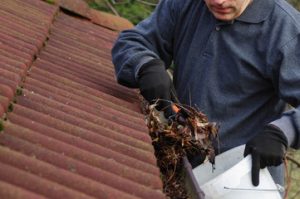Gutters that clog cause water to overflow from the gutters, and can damage the roof and fascia of your home. Regular gutter cleaning prevents these problems, and helps ensure that your home is protected for years to come.

Gutter Cleaning isn’t a glamorous job, but it’s one that’s essential to protecting your home. Visit Website for some tips to make it easier and safer.
Gutters are essential to a home’s drainage system, but they can become overflowing with debris that prevents rainwater from flowing properly. This can cause damage to a home’s siding, windows, and roof, and it may also promote the growth of mold and wood rot. Gutter cleaning is an important chore that should be performed regularly, but it can be difficult and time-consuming if not done properly. The best way to make this chore less daunting is to have gutter guards professionally installed, which can prevent leaves from clogging your gutters and allow water to flow freely through the system.
The most common cause of clogged gutters is fallen leaves and other debris. When left unattended, these items can build up and overflow the gutters, causing water to seep into walls, windows, and ceilings. This excess moisture can cause significant damage over time, leading to wood rot, mold, and structural failure. Gutter clogs are a major cause of water damage to homes, so regular maintenance is necessary.
Another reason why gutter cleaning is essential is that it can improve a home’s curbside appeal. Overflowing gutters are unsightly and can stain the siding of a house, as well as degrade the appearance of roofing shingles. When the debris is removed, the exterior of a house can be restored to its original beauty.
In addition, clogged gutters can encourage the growth of weeds and other unwanted plants around the house. The accumulated trash provides a source of nutrients for the growth of these plants, which can be a health hazard for people and pets. Regular gutter cleaning can eliminate these problems by getting rid of the organic waste and eliminating bug breeding grounds.
Gutter cleaning is most effective when it is performed on a routine basis, usually twice a year. The exact frequency of gutter cleaning depends on the location and amount of debris that accumulates in the system. Regular inspections can help homeowners to identify problems and take proactive measures to prevent them from becoming more serious. For example, if the gutters are situated close to large trees, having the trees trimmed can help to reduce the number of leaves that fall into the gutters.
Debris
Clogged gutters are often caused by leaves, sticks, twigs, pine needles, and other debris that can block water flow and cause damage to your home. Regular gutter cleaning removes these items, preventing the buildup of debris and clogs that can lead to serious damage over time.
Using specialized gutter cleaning tools ensures a thorough clean, and focuses on removing the most dangerous types of debris. Many of the professional gutter cleaning tools include high-powered blowers for twigs and other small debris, extension tools to reach high areas, and vacuum systems to remove clogs and larger particles. In addition to these tools, professionals use proper ladder safety and personal protective equipment, such as gloves and face masks, to prevent injury.
Gutter cleaners come in a variety of sizes and shapes to handle different sized gutters. In general, they are long and thin to fit into the trough of your gutter system. They are designed with a front scooping edge that easily clears debris and a back scooping edge for hard-to-reach areas. Most have a hose attachment, allowing you to add water pressure to the tool for extra cleaning power.
The best way to know when it’s time for a gutter cleanup is by paying attention to your gutters during rainy weather. If your gutters overflow during rainfall, this is a sign that they’re clogged with debris and need to be cleaned. You can also keep an eye out for mud or water stains on the exterior of your home or along the foundation, which could indicate that your gutters aren’t directing water away from your house properly.
A good rule of thumb is to check your gutters twice a year, once in the spring and again in the fall. However, if you notice any of the telltale signs mentioned above, be sure to check your gutters sooner. This can help you avoid costly repairs or replacements down the road. Gutter cleaning is one of the simplest DIY tasks for homeowners, but it’s still important to follow the right steps to complete the task safely.
Clogs
Gutter clogs can cause water to back up over gutters and pour down the sides of the house or down near the foundation, which causes water damage. Water leaking from the downspouts can also make walkways slippery, weaken your home’s foundation, and cause basement flooding. You can often clear up a clogged downspout by simply scooping the debris or spraying it away with a garden hose. For more stubborn clogs, try feeding a drum auger into the downspout to break them apart.
The most common cause of clogged gutters is leaves and debris that clog the mesh screen that covers one or more downspouts. This material is designed to filter the debris and prevent it from travelling down the downspout and choking underground drain pipes. However, this screen can become clogged with leaves and other debris, which requires you to climb a ladder and remove it.
Other types of debris that can clog gutters include wood chunks, twigs, and small branches that fall from trees during stormy weather. They are typically heavier than the leaves and more difficult to remove from gutters. The best way to prevent these clogs is to keep the trees around your home trimmed back so that they don’t fall on or into the gutters.
Another sign of a clogged gutter is that you notice plant growth inside or on the edge of the gutters. While this may not sound alarming, it’s important to remove the plant or tree as soon as possible, as it can damage your gutter system and obstruct the flow of rainwater through it.
The best way to prevent clogs is to inspect and clean your gutters regularly, especially after a major storm or before the beginning of the rainy season. Depending on the area in which you live and the number of trees in your yard, you should perform inspections and cleanings at least twice a year: once in the fall and once in the spring. If you are unable to do this on your own, consider hiring professional gutter cleaners to ensure that your gutters are in good condition for the rainy season.
Safety
Gutter cleaning is a labor-intensive, physically challenging project that exposes individuals to numerous risks. Falls from ladders account for a significant percentage of home improvement accidents, so it is critical to take the proper precautions to prevent injuries while working on a ladder.
Ladder safety begins with a thorough inspection of the surrounding area before starting any work. Identify any potential hazards, such as overhead power lines or unstable ground, and avoid these areas. It is also essential to choose a sturdy ladder that is properly rated for the weight of one individual. Lastly, it is important to use a ladder stabilizer to minimize the risk of falls.
Wearing Personal Protective Equipment (PPE) is another crucial component of gutter cleaning safety. Gloves are recommended to protect hands against dirty, rotting debris that can contain bird, pigeon, and squirrel droppings – all of which are ridden with bacteria. Thick suede gloves are preferable to cotton or rubber gloves, which tend to shrivel up when they get wet and expose skin to germs. Eye protection is also a must. Gutter cleaning debris can include twigs, shingle fragments, and sharp metal shards that may fly away when they are removed from the gutters. Investing in protective eyewear is an inexpensive way to prevent serious injury from these flying objects.
Once on the roof, it is important to start by rinsing off the debris from the gutter with a hose. This helps to remove any tree leaves or pine needles that may have fallen into the gutter during or after a rainstorm, preventing them from getting clogged again later on. It is also a good idea to spray down the drain spout with water to help dislodge any remaining clogs. If the spout is completely blocked, a plumber’s snake can be used to break up the clog.
Finally, it is vital to use a ladder that can support the weight of one individual and that is stable enough to reach all parts of the roof. Avoid ladders with only three legs, which can easily shift and put one at risk of falling off. Those who are not comfortable using a ladder should consider hiring a professional to complete the task safely.
